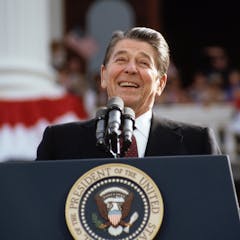
Artículos sobre Ronald Reagan
Mostrando 21 - 40 de 127 artículos

The motivations for Carter’s interest in Africa are deeply personal. His record should remind all democrats, including those in Africa, to hold leaders accountable to high ethical standards.

Russia is walking away from the last remaining treaty designed to limit the proliferation of nuclear weapons.

Conservatives have a long history of contorting the words of Martin Luther King Jr. to further political goals at odds with King’s vision of a colorblind society.

Bret Easton Ellis’s grotesquely violent novel is irreducibly misogynist, racist and homophobic. So was Reagan’s America. It’s less darkly comic satire than deadly serious social diagnostic.

The Unfolding is fiction: a made-up story of American politics. But just like in the real United States, the lines between truth and fantasy in this novel are perilously thin.

Ronald Reagan may have been known as ‘The Great Communicator,’ but rap artists don’t view his legacy through such rose-colored glasses. A professor of Black studies and history takes a closer look.

The INF treaty signed by Gorbachev and US president Ronald Reagan prohibited medium-range missiles.

With a formidable Kremlinologist in charge and Donald Trump out of the presidential picture, has the CIA regained its influence amid the ‘new cold war’?

Young queer people growing up in rural areas don’t necessarily need to flee their communities to find safety and acceptance.

The word ‘neoliberal’ gets thrown around a lot, often with differing and even contradictory meanings. Here, a political economist explains the origins and evolution of this complex concept.

Russia is raising the stakes with upgraded ballistic missiles and blood-curdling threats from the Kremlin

Substitute Russia for the Soviet Union and it’s clear why the cult Cold War action movie Red Dawn has found a new fan base nearly 40 years on.

According to some reports, thousands of people from around the world are signing up to fight on behalf of Ukraine. But comparisons to the Spanish Civil War’s International Brigades are misguided.

A tax expert explains why the US continues to use such a complex and costly income tax system.

To the famous composer, the gun serves not as a tool of self-defense, but as an instrument of self-expression and self-realization.

Joe Biden may be only the country’s second Catholic president, but a long line of U.S. leaders have met with popes over the years.

Donald Trump’s lawsuit to stop the release to Congress of potentially embarrassing or incriminating documents puts the National Archives in the middle of an old legal conflict.

A scholar of African American studies explores how the former secretary of state, who died at 84, dealt with what WEB DuBois described as the ‘double-consciousness’ of being Black and American.

For much of the country’s history, the Republican Party was the party of Lincoln and racial equality, and the Democratic Party backed Jim Crow laws and white supremacy. The two parties switched.

A religion scholar explains how evangelicalism in the US is not a monolith. It includes a a variety of churches, theologies and practices.
